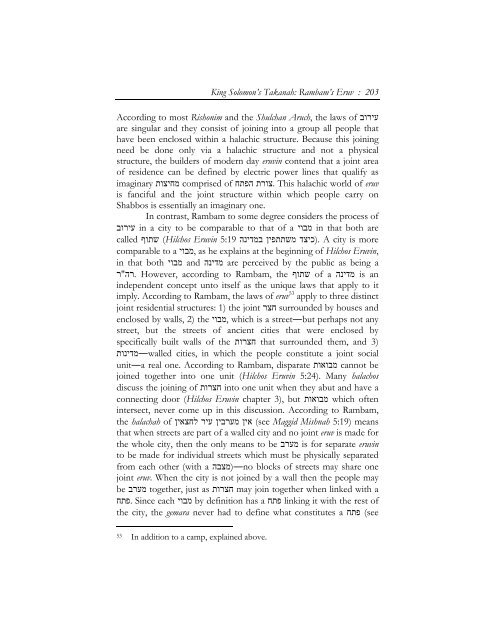King Solomon's Takanah: Rambam's Eruv - Hakirah.org
King Solomon's Takanah: Rambam's Eruv - Hakirah.org
King Solomon's Takanah: Rambam's Eruv - Hakirah.org
Create successful ePaper yourself
Turn your PDF publications into a flip-book with our unique Google optimized e-Paper software.
עי<br />
רה<br />
<strong>King</strong> Solomon’s <strong>Takanah</strong>: Rambam’s <strong>Eruv</strong> : 203<br />
עירוב According to most Rishonim and the Shulchan Aruch, the laws of<br />
are singular and they consist of joining into a group all people that<br />
have been enclosed within a halachic structure. Because this joining<br />
need be done only via a halachic structure and not a physical<br />
structure, the builders of modern day eruvin contend that a joint area<br />
of residence can be defined by electric power lines that qualify as<br />
imaginary מחיצות comprised of הפתח .צורת This halachic world of eruv<br />
is fanciful and the joint structure within which people carry on<br />
Shabbos is essentially an imaginary one.<br />
In contrast, Rambam to some degree considers the process of<br />
in that both are מבוי in a city to be comparable to that of a רוב<br />
called שתוף (Hilchos משתתפין במדינה <strong>Eruv</strong>in 5:19 .(כיצד A city is more<br />
comparable to a ,מבוי as he explains at the beginning of Hilchos <strong>Eruv</strong>in,<br />
in that both מבוי and מדינה are perceived by the public as being a<br />
is an מדינה of a שתוף . However, according to Rambam, the "ר<br />
independent concept unto itself as the unique laws that apply to it<br />
imply. According to Rambam, the laws of eruv 53 apply to three distinct<br />
joint residential structures: 1) the joint חצר surrounded by houses and<br />
enclosed by walls, 2) the ,מבוי which is a street―but perhaps not any<br />
street, but the streets of ancient cities that were enclosed by<br />
specifically built walls of the חצרות that surrounded them, and 3)<br />
walled―מדינות cities, in which the people constitute a joint social<br />
unit―a real one. According to Rambam, disparate מבואות cannot be<br />
joined together into one unit (Hilchos <strong>Eruv</strong>in 5:24). Many halachos<br />
discuss the joining of חצרות into one unit when they abut and have a<br />
connecting door (Hilchos <strong>Eruv</strong>in chapter 3), but מבואות which often<br />
intersect, never come up in this discussion. According to Rambam,<br />
the halachah of אין (see Maggid Mishnah 5:19) means<br />
that when streets are part of a walled city and no joint eruv is made for<br />
the whole city, then the only means to be מערב is for separate eruvin<br />
to be made for individual streets which must be physically separated<br />
from each other (with a no―(מצבה blocks of streets may share one<br />
joint eruv. When the city is not joined by a wall then the people may<br />
be מערב together, just as חצרות may join together when linked with a<br />
אין מערבין עיר לחצ<br />
linking it with the rest of פתח by definition has a מבו י Since each .פתח<br />
the city, the gemara never had to define what constitutes a פתח (see<br />
53 In addition to a camp, explained above.
















